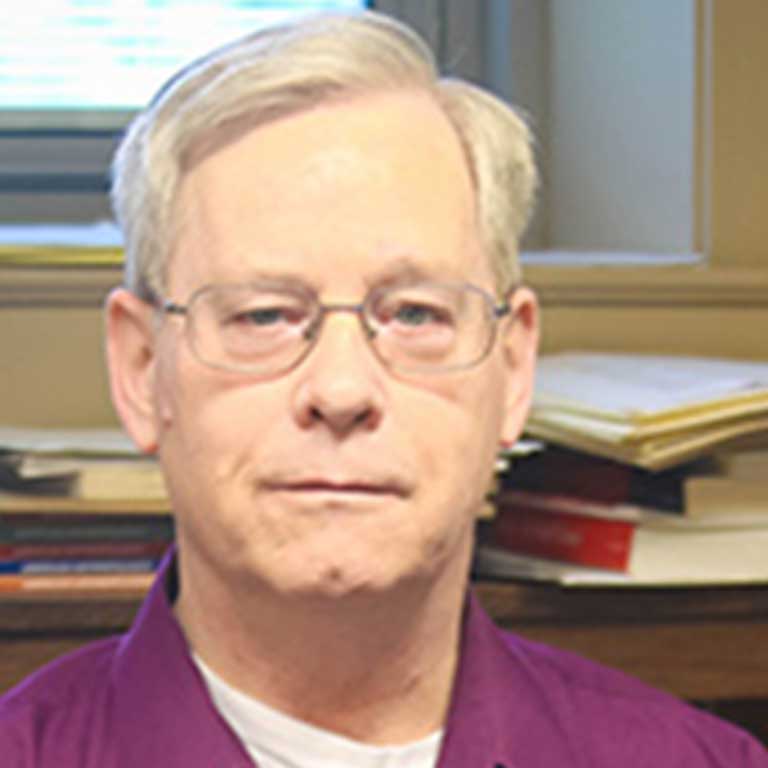- Ph.D., Massachusetts Institute of Technology, 1989
- S.B., Massachusetts Institute of Technology, 1974

Philip S. Lesourd
Professor Emeritus, Anthropology

Professor Emeritus, Anthropology
Geographical areas of specialization
Northeastern North America
Research Interests
linguistic theory and its application to the analysis of Native American languages; comparative Algonquian linguistics; Maliseet-Passamaquoddy
The founders of the Americanist tradition in anthropology, Franz Boas and Edward Sapir, regarded linguistics as an essential part of their discipline. Indeed, for much of the last century, anthropology departments were the primary centers of linguistic research in this country. With the rise of departments specifically devoted to linguistic studies, however, the fields of linguistics and anthropology have tended to diverge, and thus to lose track of the contributions that each can make to the other. In my teaching, I seek to bridge this gap, to show how an understanding of the nature of language can contribute to our understanding other areas of culture, and to demonstrate how research in cultural anthropology, archaeology, and physical anthropology can provide essential insights for historical and analytical work in linguistics. Since linguistic analysis can only be learned by doing it, my courses place a strong emphasis on problem sets that give students hands-on experience in analyzing linguistic data.
My research focuses primarily on issues in the structure of languages of the Algonquian family, the most widespread linguistic stock in North America. My specialty within this domain is Maliseet-Passamaquoddy, an Eastern Algonquian language spoken in New Brunswick (Maliseet) and Maine (Passamaquoddy).
I received my first introduction to the Maliseet-Passamaquoddy language in the spring of 1975, when I attended a joint meeting of several Micmac, Maliseet, and Passamaquoddy groups in Fredericton, New Brunswick, a conference that was being held to discuss writing systems for these languages to be used in several newly founded bilingual education programs. Somehow I wound up spending an afternoon riding around Fredericton with a carload of Passamaquoddies from Maine, who had decided to speak no English that day. While I understood not a word that anyone was saying, I thought the language sounded like music. (I would later learn that Maliseet-Passamaquoddy is a pitch accent language: the “tunes” to which individual words are “sung” do indeed play a fundamental role in the language.) I was hooked.
I began working with the language in the summer of 1976, when I was hired by the Wabnaki Bilingual Education Program at Indian Township, ME, to organize a dictionary project. The project produced a dictionary of a few thousand words that was published by the Micmac-Maliseet Institute in Fredericton, N.B., in 1984. That early dictionary work was continued by a community-based project at Pleasant Point, ME, which has developed a dictionary database with over 16,500 entries, many with sound files, available on line at www.lib.unb.ca/Texts/Maliseet/dictionary. In 2007, Peskotomuhkati Wolastoqewi Lautuwewakon / A Passamaquoddy-Maliseet Dictionary was published (Orono, ME: University of Maine Press), with more than 18,000 entries.
More recently, I have been involved in editing Maliseet and Passamaquoddy texts. For one project, I transcribed and translated a collection of material that was tape-recorded in New Brunswick in 1963 by Karl V. Teeter of Harvard University, which includes tales told by a number of elders who were born before 1900. For another project, I am investigating nineteenth century religious texts in Passamaquoddy and its neighbor to the southwest, Penobscot. I am also working on several areas of the syntax of Maliseet-Passamaquoddy and taking a look at aspects of the structure of another related language, Western Abenaki.
This website is intended to make information about my classes in both Anthropology and Second Language Studies available to current and prospective students. It also aims to make my research on Native American languages (primarily Maliseet, Passamaquoddy, and Abenaki) more readily available to Native people, scholars, and the general public.
2021. LeSourd, Philip S. Reflections of Passamaquoddy shamanism in a nineteenth-century text. In David Costa, Lucy Thomason, and Amy Dahlstrom (eds.), Webs of relationships and words from long ago: A festschrift presented to Ives Goddard on the occasion of his 80th birthday, 191-211. Petosky, MI: Mundart Press.
2019. LeSourd, Philip S. Raising and long distance agreement in Passamaquoddy: A unified analysis. Journal of Linguistics 55:357–405.
2018. LeSourd, Philip S. Four poems in Passamaquoddy. Anthropological Linguistics 60:195–225.
2015. LeSourd, Philip S. Enclitic particles in Western Abenaki: Form and function. International Journal of American Linguistics 81:301–335.
2014. LeSourd, Philip S. Prepositional phrases in Maliseet-Passamaquoddy. International Journal of American Linguistics 80:209–240.
2013. LeSourd, Philip S. Does Maliseet-Passamaquoddy have VP-Ellipsis? Linguistic Inquiry 44:285–298.
2007. LeSourd, Philip S. Tales from Maliseet country: The Maliseet texts of Karl V. Teeter. Lincoln: University of Nebraska Press.